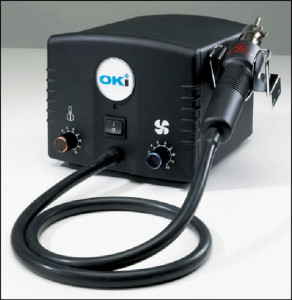Hot-air rework system | De-soldering Equipments

To de-solder SMD components, hot-air rework systems are used. How they work is exactly opposite to how vacuum-pump type systems operate. Hot-air rework systems blow hot air on the target component, melting the solder. Once the solder has melted, the component is removed using regular tweezers or positioner. You will still have some solder on the pads, which is then removed by the vacuum pump type de-soldering system. Fig. 5 shows such a rework station.
There are normally two controls in such systems—the temperature control and air-flow control. You will need different temperatures and air pressure for different SMD joints. Normally, thick joints will need higher-temperature blown air to melt all the solder. The important thing here is that the solder on each pin should melt completely, otherwise it will be impossible to remove the component from the PCB.
The disadvantage of such a system is that the impact is not very targeted and even the neighbouring components are affected. Sometimes, the small components even get blown away in the more dense boards. Though there are different-sized nozzles available, and small nozzles work well in close areas, you may still damage other components if you are not careful.
The specifications for such systems are simple and self-explanatory. Temperature control, power consumption, temperature range and ESD-safe has already been explained in the case of vacuum-pump type rework systems, and those descriptions apply in this case too. As the name suggests, the airflow specification gives you an idea of the system’s capacity to blow air.
Heated tweezers
Heated tweezers have more targeted heat transfer than hot-air rework stations. They provide a fast, efficient method to solder and de-solder surface mount devices such as chip resistors, chip capacitors, SOTs, flat packs and DIP ICs. They normally have dual-insulated heating elements to ensure rapid heating and recovery. These devices come with a wide variety of interchangeable tips that are available in a range of widths, from 2 mm to 30 mm. Fig. 6 shows a pair of heated tweezers.

All the specifications for heated tweezers are the same as those discussed in relation to vacuum-pump type de-soldering stations.
BGA rework station
All the tools mentioned above will not be able to de-solder a BGA (ball grid array) from the PCB. De-soldering BGAs is much more complicated than other rework operations and requires more sophisticated equipment. The main differences in BGA rework stations are the heating source and mode. Rework stations with upper-heating and both-side heating are the two types available in the market. The both-side heating mechanism is more suitable, if one considers the component’s safety. Some also have a feature to set the temperature curve. The pre-heat function is also useful to prevent the PCB from warping during repairs.
For reading more exciting buyer’s guide: click here
The author is a technical editor at EFY






